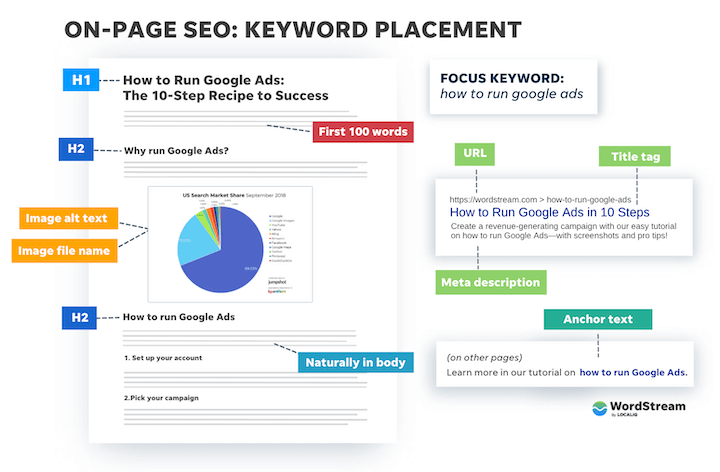Improving website content for SEO is crucial for better search rankings. It helps attract more visitors and boosts online visibility.
In today’s digital world, having a website isn’t enough. You need content that search engines and users love. SEO-friendly content is key. It means writing in a way that makes your site rank higher on search engines. Better content means more traffic, leads, and sales.
But how do you improve your content for SEO? It involves several strategies, from keyword research to creating engaging and relevant information. This guide will help you understand these strategies. You’ll learn how to make your content better for both search engines and visitors. Let’s explore the best practices for improving your website content for SEO.
Keyword Research
Keyword research is the cornerstone of SEO. It helps you understand what terms your audience uses to find content. By identifying these keywords, you can tailor your content to meet their needs. Let’s dive into the basics of keyword research.
Finding Relevant Keywords
Start by brainstorming a list of words related to your topic. Think about what your audience might search for. Use tools like Google Keyword Planner or Ubersuggest. These tools can provide a list of relevant keywords. Check the search volume for each keyword. Higher search volumes indicate more interest. Balance high volume with lower competition. Long-tail keywords are longer phrases. They are more specific and often less competitive. They can help attract targeted traffic.
Analyzing Competitor Keywords
Look at your competitors’ websites. See what keywords they use. Tools like SEMrush or Ahrefs can help. Enter your competitor’s URL into the tool. You’ll get a list of keywords they rank for. Check for keywords with high search volume and low competition. These are your opportunities. Create content around these keywords. Ensure your content is more comprehensive and valuable. This way, you can outrank your competitors.

Credit: www.lumar.io
Quality Content Creation
Creating quality content is crucial for improving your website’s SEO. Search engines favor content that is engaging, informative, and relevant. This section explores key strategies to enhance your content quality, making it more appealing to both readers and search engines.
Crafting Engaging Headlines
Headlines are the first things users notice. They should grab attention and entice users to read further. Here are some tips for crafting engaging headlines:
- Keep it concise: Aim for 50-60 characters to ensure readability on all devices.
- Use numbers: Numbers can make headlines more attractive. For example, “5 Tips for Better SEO”.
- Include keywords: Incorporate relevant keywords naturally to improve search engine visibility.
- Create curiosity: Pique the reader’s interest. For instance, “Discover the Secrets of SEO”.
Writing In-depth Articles
In-depth articles provide comprehensive information on a topic. They are more likely to be shared and linked to. Consider the following:
- Research thoroughly: Gather information from credible sources to ensure accuracy and depth.
- Use subheadings: Divide content into sections with clear subheadings for easier reading.
- Incorporate visuals: Add images, infographics, and videos to make the content more engaging.
- Provide value: Offer practical advice, tips, and insights that readers can apply.
- Optimize readability: Use short paragraphs, bullet points, and simple language to maintain interest.
By focusing on creating high-quality content, your website can attract more visitors and improve its search engine ranking.
On-page Seo Techniques
On-page SEO techniques are essential for improving your website’s search engine ranking. They help search engines understand your content better. This section will cover three key techniques: optimizing meta descriptions, using header tags effectively, and more.
Optimizing Meta Descriptions
Meta descriptions give a brief overview of your page content. They appear in search results under the page title. To optimize them:
- Keep them under 160 characters.
- Include your main keyword.
- Write compelling and relevant descriptions.
Here’s an example of a well-optimized meta description:
Using Header Tags Effectively
Header tags (H1, H2, H3, etc.) structure your content. They make it easier for search engines and users to read. Follow these tips for effective use:
- Use one H1 tag for the main title.
- Use H2 tags for subheadings.
- Use H3 tags for sub-subheadings.
Proper header tag usage helps search engines understand your content hierarchy. It also improves user experience by making your content more readable.
Below is an example of structured content with header tags:
On-Page SEO Techniques
Optimizing Meta Descriptions
Why Meta Descriptions Matter
Using Header Tags Effectively
Best Practices for Header Tags
Using header tags correctly can boost your on-page SEO efforts.

Credit: www.wordstream.com
Content Formatting
Content formatting plays a crucial role in enhancing website content for SEO. Proper formatting helps readers easily scan and understand your content. This results in longer dwell time and lower bounce rates. Both are positive signals for search engines. Let’s dive into some effective content formatting techniques.
Utilizing Bullet Points
Bullet points break down information into digestible pieces. They make lists easy to read and understand. Use bullet points to highlight key details. Readers can quickly grasp the main points without reading long paragraphs. This improves the overall user experience.
Incorporating Visuals
Visuals make content more engaging. They help illustrate points and break up text. Images, infographics, and videos can capture attention. Use high-quality visuals relevant to your content. Add alt text to images for better SEO. It helps search engines understand the image content.
Remember to compress images to reduce load times. Fast-loading pages improve user experience and SEO rankings. A balanced mix of text and visuals keeps readers interested.
Internal Linking
Internal linking is a key part of SEO. It helps search engines understand your website. It also keeps users on your site longer. By linking to other pages, you improve your site’s structure. This makes it easier for users and search engines to navigate. Let’s explore the best practices for internal linking.
Building Link Structures
A good link structure is essential. Start by identifying your main pages. These are your cornerstone content. Link to these pages from other relevant content. This helps distribute link equity. It also improves the visibility of important pages.
Use a silo structure. Group related content together. Link between these related pages. This creates a clear hierarchy. Search engines can then understand the context of your content. Users will also find it easier to navigate.
Using Anchor Text Wisely
Anchor text is the clickable text in a hyperlink. Use descriptive anchor text. It should tell users what the linked page is about. Avoid generic phrases like “click here”. These do not help with SEO. Descriptive anchor text improves context. Search engines use this to understand the content.
Be natural with your anchor text. It should fit into the sentence smoothly. Avoid keyword stuffing. Too many keywords can look spammy. This can harm your SEO. Aim for a balanced approach. Use keywords where they make sense.

Credit: www.mtu.edu
Mobile Optimization
Mobile Optimization is crucial for enhancing website content for SEO. With more users accessing websites via mobile devices, ensuring your website is mobile-friendly is essential. This not only improves user experience but also boosts your search engine rankings. Here are some key areas to focus on for effective mobile optimization:
Ensuring Responsive Design
Responsive design ensures your website adjusts to any screen size. This provides a seamless experience for users on any device.
- Use a responsive theme or template.
- Test your website on multiple devices.
- Ensure text and images resize correctly.
- Make sure navigation is user-friendly on all devices.
A responsive design improves user engagement and reduces bounce rates. This is vital for better SEO performance.
Improving Page Load Speed
Page load speed is a critical factor in mobile optimization. Users expect fast loading times, especially on mobile devices.
- Optimize images: Use compressed images to reduce load times.
- Minimize code: Remove unnecessary code from your website.
- Enable browser caching: Store static files in the user’s browser for faster access.
- Use a Content Delivery Network (CDN): Distribute your content across multiple servers to speed up load times.
Faster page load speeds enhance user experience and improve your SEO rankings.
User Experience Enhancements
Improving user experience (UX) is crucial for website content optimization. A good UX keeps visitors engaged and encourages them to explore more pages. Enhancing UX directly impacts SEO by reducing bounce rates and improving site navigation. Below, we discuss key strategies for enhancing user experience.
Improving Navigation
Effective navigation helps visitors find what they need quickly. A well-structured navigation system boosts user satisfaction and search engine rankings.
- Clear menu structure: Use simple, descriptive labels for menu items. Avoid jargon.
- Breadcrumbs: Add breadcrumbs to show users their location within the site.
- Search function: Implement a search bar to help users find content easily.
Reducing Bounce Rates
High bounce rates indicate users leave your site without engaging. Reducing bounce rates can improve your SEO performance.
- Improve page load speed: Fast-loading pages retain user attention.
- Engaging content: Create valuable, relevant content that meets user needs.
- Responsive design: Ensure your site is mobile-friendly for better user experience on all devices.
Implement these strategies to enhance your website’s UX. Better UX leads to improved SEO and higher user satisfaction.
Monitoring And Analytics
Monitoring and analytics are essential in improving website content for SEO. These tools help understand how well your website performs. They guide adjustments to enhance visibility and user engagement. By closely watching data, you can make informed decisions.
Tracking Performance Metrics
Performance metrics provide insights into your website’s effectiveness. Key metrics include page views, bounce rates, and average session duration. These data points reveal how users interact with your content. Tools like Google Analytics are useful for tracking these metrics. They offer detailed reports on user behavior and site performance.
Regularly reviewing these metrics helps identify areas needing improvement. For example, a high bounce rate suggests users leave your site quickly. This could mean your content isn’t engaging enough. Or it could indicate slow page load times. Addressing these issues can improve user experience and SEO.
Adjusting Strategies Based On Data
Data-driven adjustments are vital for continuous improvement. Analyze the collected data to find trends and patterns. This helps in refining your content strategy. If a specific type of content performs well, create more of it. If certain keywords attract more traffic, focus on them.
Make changes based on what the data shows. If users spend more time on pages with videos, add more video content. If blog posts with images have higher engagement, include more visuals. Regularly updating your strategy ensures your content remains relevant and engaging.
In conclusion, monitoring and analytics are crucial for optimizing website content. By tracking performance metrics and adjusting strategies based on data, you can improve SEO and user experience.
Frequently Asked Questions
How Can I Improve Website Content For Seo?
Improving website content for SEO involves keyword research, creating high-quality content, and optimizing meta tags. Use engaging headlines, add internal and external links, and ensure mobile-friendliness.
What Are The Best Seo Practices For Content?
Best SEO practices include using relevant keywords, optimizing title tags, and creating high-quality, original content. Ensure proper use of headings, internal linking, and fast page loading times.
How Often Should I Update My Website Content?
Regularly updating your content keeps it fresh and relevant. Aim to review and update key content every 3-6 months. This helps maintain SEO rankings.
Why Is Keyword Research Important For Seo?
Keyword research helps identify terms your audience searches for. It ensures your content meets user intent and ranks higher in search results.
Conclusion
Improving website content for SEO is essential. Focus on quality and relevance. Keep sentences short and clear. Use keywords wisely but don’t overdo it. Engaging content keeps readers on your site longer. Update content regularly to stay current. Good content leads to better rankings.
Consistency is key. Follow these tips and see your site’s performance improve. Remember, good SEO practices make a big difference. Happy writing!